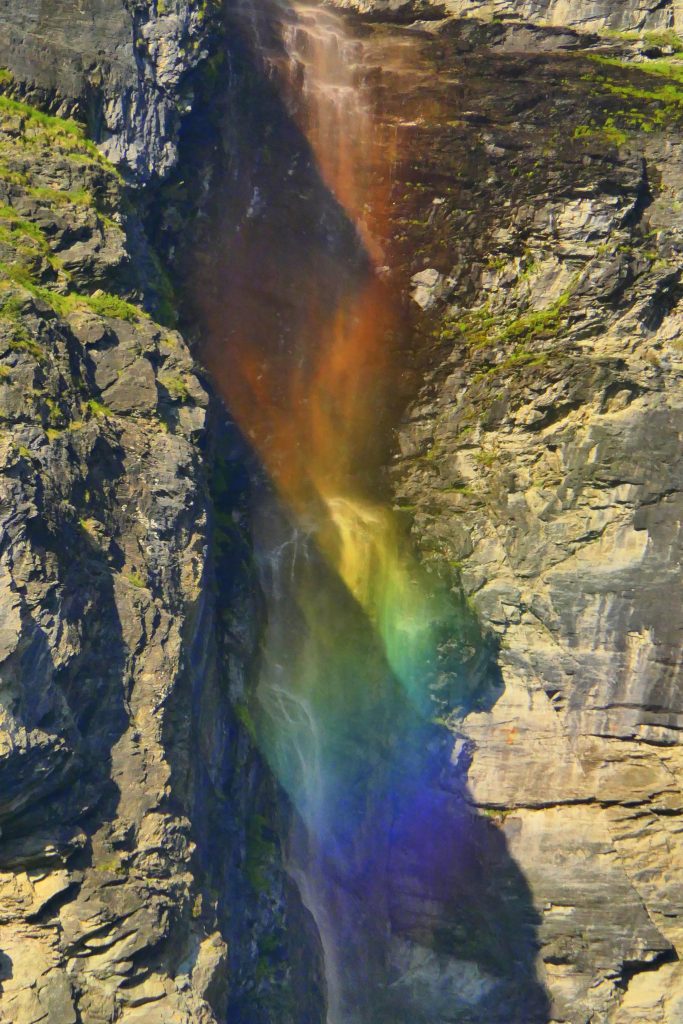Today we started off with a warm up run where I observed each skier’s progress. Both were clearly using dynamics going into the turns. For individual feedback Shane needed to work on angulation and being more forward to prevent falling onto the inside ski during the turn. Ailbhe also needed to be more forward and we had to figure out why her stance was so wide and rigid looking.
Perpendicularity
I explained how we always centre ourselves perpendicular to the hill – that is “vertical” when standing across the hill and at right angles to the slope when sliding straight downhill. Most untrained people reflexively stand vertical – hence lean against the backs of the ski boots when sliding downhill.
Turn Exit Dynamics
When using “racing” dynamics the turn is only completed when during the turn transition (between the end of one turn and the start of the next) the skis go flat on the slope while travelling across the slope – and the skier crossing over the skis is perpendicular to the slope.
The turn is completed by using the loading up of the outside ski – finishing the turn and resisting gravity – accessing this energy for the purpose of lifting the body up and out of the turn – analogous to a motorbike coming up and out of a turn. (Shane – FINISH your turns!!!)
It takes experience and confidence to exit the turn this way with the centre of mass as there is now nothing below you on the mountain holding you up – other than the next turn itself.
Using dynamics out of a turn ensures there is no traverse in between turns – but a strong rhythm is generated instead. This is where power for effective off piste skiing can be generated for dealing with difficult snow. The “down / up” motion should feel natural because the skis are designed for this action. Greater steepness requires greater commitment – so be mentally prepared for that.
Don’t then forget to extend the new uphill leg to push the centre of mass down into the next turn.
Pole Touch
The centre of mass once across the skis and falling downhill is then used to touch the tip of the downhill pole on the ground for feedback. There’s no movement of the arm – no extending it forward or down – just a small flick forward of the pole with the wrist. The poles are like antennae for the centre of mass.
Angulation
Angulation with a forward tilt of the upper body at the hip makes it easier to ensure keeping pressure on the fronts of the skis during both the turn exit and especially the entry of the centre of mass into the next turn.
Pivot
Pivoting is about having the skis working sideways and always as brakes – with no free dynamics – the dynamics always being strongly controlled with weight on one ski pole at a time. This takes a little bit of practice. The “Pivot” link at the top of this page gives a detailed breakdown of pivoting with demonstration videos. Pivot and Dynamics have as a common denominator the fact that EVERYTHING is pulled into the turn centre until the moment the centre of mass is allowed to cross the skis in the turn exit. With the pivot the centre of mass never moves far from the vertical. Pivoting is vertical – braking skiing – ideal for narrow steeps, bumps, soft fresh snow and narrow pathways.
Most turns on skis have a short pivoting phase at the very start of the turn – especially if the uphill leg push into the new turn starts from the uphill edge.
In the video both Shane and Ailbhe picked up the principle of pivoting well losing their tendency to flick the ski tails outward. Ailbhe finally understood what to do with her feet inside the boots and the pivoting massively improved her stance. Ailbhe’s skiboots had a flex DIN of 65 and despite someone already cranking the shaft adjustment over to get maximum inside edge – the boots were under-edged by far – making it really difficult for Ailbhe to be able to skate. I’d seen this when giving a skating “free-fall” exercise to try to get Ailbhe more independent with her legs – but ended up seeing that the boots were her main problem there. To be direct about it – they are the worst ski boots I think I’ve ever seen. I hope priority has been given to changing them. Nothing less than flex DIN 90 and a boot structure that allows the soles to be flat when the legs are locked out straight with feet at hip width apart (sitting on the edge of a chair). Never tell an equipment hire shop that you are a beginner or lower level skier!



